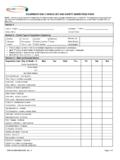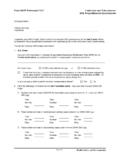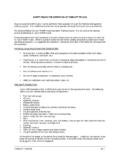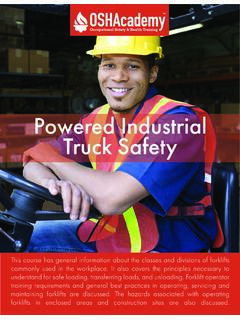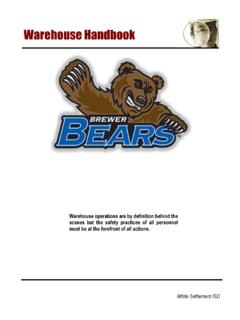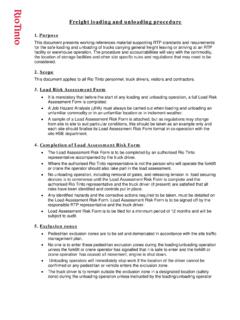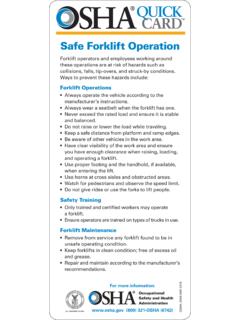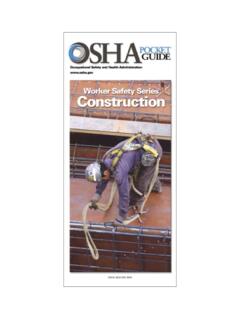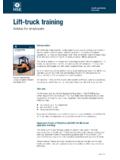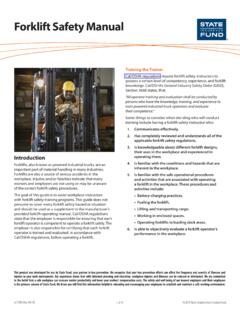Transcription of Job Hazard Analysis JHA Suffix Number: 13-1647
1 Job Hazard AnalysisJHA Suffix Number: 13-1647 Revision:6 JHA orJob-SpecificGeneralJHA Issue Date3/2/2017 Expiration DateNADescription of WorkGeneral Work JHAA ddresses common (neither unique nor substantial Hazard ) work activities conducted by FBP and its Construction Support LocationPORTSA ctivity or Area NameGeneral SiteFacility or ProjectSite WideSpecific LocationJHA REVISION LOG (As Applicable)Rev. LevelDateRevision DescriptionPage(s)16/24/20151. Changed description to remove reference to "excluded work" and added focus on common work activitiesacross the Deleted commercial shredding Deleted equipment/vehicle activities in process buildings, operation of motorized carts. Will be added toSite Safety Added "CORE" controls for noise, fall hazards, radiation, environmental, confined space, and ladder Added noise exemption in Activity Added chemical usage exemptions in Activity Added ' truck -Mounted Lift Gate operations ' Added 'Temperature Extremes (Cold Stress)' Added 'Refueling' Added 'Dispatched Work' activity for release of hazardous energy and fixed weld shop Added 'Performing Work in a HOT Environment' Added 'Conduct Outdoor Work Activities' Spotter PPE language to approximate that of procedure; modified Refueling controls regarding needfor spill kit and removed PPE (gloves); added Operation of Pallet , 18, 2037/19/2016 Added 'Struck By' Hazard and controls for Portable Ladder use; modified 'Release of Hazardous Energy' Hazard and controls; added voltage-rated rubber gloves as control for shock Hazard .
2 Added controls for palletjack 'Caught Between/Crush' and 'Struck By' ,8,19,2049/20/2016 Added activity 'Working in Non-Permit-Required Confined Space (non-PRCS)'; revised Activity 20. description;added activities 'Performing Work in Areas with Elevated Noise Levels' and 'Performing Manual MaterialHandling Tasks'.16,20,22512/19/2016 Added Hazard control for 'Fall to elevation ' Hazard of Activity 5; modified last control for 'Contact withelectric lines' Hazard of Activity 7; modified control for 'Fixed ladder malfunction' Hazard of Activity 8; addedActivity 26 'Work Activity Impacting, or Impacted By, Fissile Material' to address MTS Item #4434; addedActivity 27 'Work in Areas with Inadequate Lighting'.5,8,9,2463/2/2017 Added activity 'Scaffold Erection, Access,..'; added activity 'Use of Portable Pumps and Generators'; modifiedoverhead clearance language of 'Electric Shock' Hazard throughout; other miscellaneous changes ,28,AllPage 1 of 30 JHA No: FBP-JHA- 13-1647 Author: Kevin J.
3 O'Day34 total pagesJob Hazard AnalysisJHA Suffix Number: 13-1647 Revision:6 Work Activity, Task, or JobStepPotential Hazard (s) Hazard Control(s)1. Activities Requiring the Use of ASpotterNOTE: For the purposes of thisJHA, spotters are required foractivities where: Driver/operator has limitedvisibility in the direction thevehicle/ equipment/forklift istraveling or when the point ofoperation is not in full view of thedriver/operator Activities in tight spots, orlocations where there is likelihoodfor personal injury by being struckby equipment, the potential forproperty damage, or there ispotential for damage to equipment In proximity to or travellingunderneath overhead hazards(communications lines, pipe runs,other utilities [except energizedelectrical]) where the clearance isless than 10-feet based on visualestimation Operation within or adjacent toan active pedestrian walkway Adjacent to a roadway wheretraffic must be maintained orcontrolled NOTE.
4 A minimum oftwo (2) spotters are required whenthe activity impacts a section of Crush Electrical Shock/Electroction Equipment Damage Pinch Point Property Damage Struck ByPersonnel designated to function as spotters shall complete FBP Spotter Safe Practices Training. Spotters shall be identified by project supervision. Supervision shall communicate to spotters including the scope of work, signal protocol to be utilized bythe spotter(s)/operators, what to do if visual or voice communication between spotter and operator islost, and walk-down routes to be utilized by vehicles, equipment, or forklifts to identify potential hazards( , potential for personnel being struck, potential for striking other moving objects/fixed objects,overhead hazards, uneven surfaces, blind intersections, etc.). Spotters shall wear high visibility clothing labeled as meeting ANSI/International Safety EquipmentAssociation (ISEA) 107, American National Standard for High Visibility Safety Apparel and HeadwearDevices, Class 2 or 3 required distinguishing clothing or devices designed to further distinguish a spotter(s) shall be atthe discretion of, and as agreed to by, the work Protective Equipment (PPE): Clothing, High-Visibility (Outer Garment)-Page 2 of 30 JHA No: FBP-JHA- 13-1647 Author: Kevin J.
5 O'DayJob Hazard AnalysisJHA Suffix Number: 13-1647 Revision:6 Work Activity, Task, or JobStepPotential Hazard (s) Hazard Control(s)PORTS roadway During loading and unloadingactivities (including semi-trailers orflatbed trailers). When directed by projectsupervision or OS&H Equipment and VehicleActivities- Operating HeavyEquipment/MachineryNOTE: This JHA does not addressthe OPERATION of heavyequipment/machinery within 10-feet or TRAVEL within 4-6 feet(depending on the voltage) ofenergized overhead electricallines. Activities performed at acloser distance than these must beaddressed by a job-specific JHA does not address theoperation of equipment to be usedto perform any type of cranes and Shock/Electrocution due tocontact with overhead energizedelectrical linesOperating equipment shall maintain a minimum clearance from overhead energized electrical wires of10-feet for voltages up to and including 50 kV.
6 NOTE: Clearance distances increase with highervoltages, beginning at >50 kV [refer to OSHA (c) and - .1411 for more information]. Traveling equipment shall maintain a minimum 4-6 foot clearance (depending on voltage) from overheadenergized electrical lines. Struck By EquipmentDamage to Equipment/FacilitiesUse only trained/qualified and licensed operators. Excavations located adjacent to active roadways shall be protected by "jersey barriers" or other FBP-approved protection devices which will function as a warning device that the mobile equipment isapproaching the edge of the excavation. Designate a trained spotter. Establish signs and barricades for the work area. OS&H shall establish safe distances from equipment for ground personnel. The minimum safe distanceshall be 30-feet. Ground personnel, with the exception of a spotter, shall not normally positionthemselves within minimum safe distance.
7 If ground personnel must position themselves within 30-feet of heavy equipment, the following shall beobserved:A. Approach the heavy equipment from the front so the operator can see you;B. Utilize hand signals or radios to contact the operator;C. The operator shall ground equipment attachment(s), place controls in a neutral configuration, and setthe equipment brakes (when equipped);D. The operator communicates (hand signals or radio) that it is okay for the ground person(s) to enterinto the area; andE. The ground person(s) shall notify the equipment operator when they have cleared the 30-ft. zone. Non-essential ground personnel shall not enter into any swing radius of operating equipment. Page 3 of 30 JHA No: FBP-JHA- 13-1647 Author: Kevin J. O'DayJob Hazard AnalysisJHA Suffix Number: 13-1647 Revision:6 Work Activity, Task, or JobStepPotential Hazard (s) Hazard Control(s)Release of Fuel or Oil into theEnvironmentSpill kits will be available at the job site.
8 Stationary equipment with fuel or oil capacity of greater than 50-gallons must have secondarycontainment. Allow sufficient distance for spill response equipment to be deployed to prevent fuel or oil from enteringditches, storm drains, ponds or streams in the event of a leak or spill. If unsure, then contact the PSS forassistance in determining what constitutes sufficient distance. 3. Equipment and VehicleActivities - Powered IndustrialTrucks ( forklifts )NOTE: This JHA does not addressthe OPERATION of poweredindustrial trucks within 10-feet, orTRAVEL within 4-6 feet(depending on voltage), ofenergized overhead electricallines. Activities performed at acloser distance than these must beaddressed by a job-specific cranes and or Unsecured Load(resulting in a falling load)Secure all loads, as necessary. Only stable or safely arranged loads shall be handled. Caution shall beexercised when handling off-center loads which cannot be centered.
9 Certain engineered loads ( ,jersey barriers with fork pockets) may NOT need to be secured if handled as designed. DO NOT rig slings to forks during rigging operations ; attach slings ONLY to an approved lifting devicethat has been evaluated and approved for use on the forklift. Use edge softeners where sling may be abraded by edge of load. Electrocution or Electric Shockfrom contact with overheadelectrical linesOperating equipment shall maintain a minimum clearance from overhead energized electrical wires of10-feet for voltages up to and including 50 kV. NOTE: Clearance distances increase with highervoltages, beginning at >50 kV [refer to OSHA (c) and - .1411 for more information]. Traveling equipment shall maintain a minimum 4-6 foot clearance (depending on voltage) from overheadenergized electrical lines. Struck By - Damage toEquipment/FacilitiesOnly trained operators shall operate forklifts .
10 When load obstructs operator view, operator must travel in reverse. Drive equipment inside buildings only when necessary to perform work. Contact the facility manager to receive a briefing on facility specific rules for equipment operation. When inside facilities, equipment shall NOT travel at speeds greater than 5 mph, or a brisk walkingpace. Page 4 of 30 JHA No: FBP-JHA- 13-1647 Author: Kevin J. O'DayJob Hazard AnalysisJHA Suffix Number: 13-1647 Revision:6 Work Activity, Task, or JobStepPotential Hazard (s) Hazard Control(s)Crush or Pinch ( , tohands/extremities when manuallyadjusting fork width)When possible, tilt the mast forward to free up forks for ease in moving forks; if the fork is too heavy tolift alone, obtain help from another worker. Handle forks away from mast components to limit exposure to pinch-points. When manually adjusting fork widths, personnel shall be aware of potential hand pinch-points.
